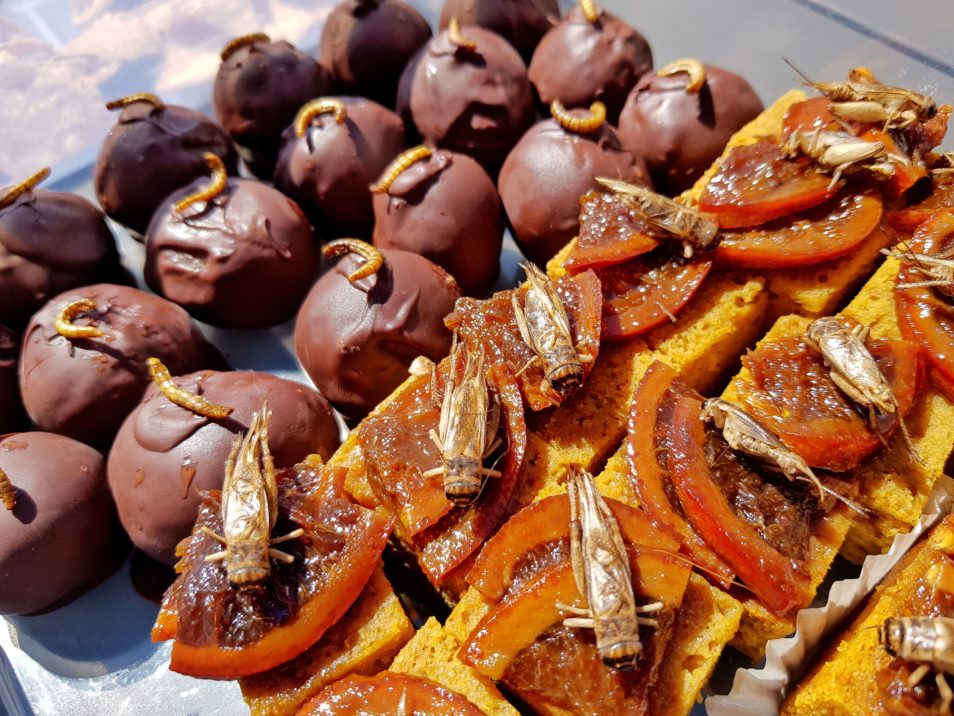
Add an extra crunch and protein hit to your snacks with edible insects! Image: Dr Bryan Lessard
Are you conscious reducing your impact on the environment? Looking to pack a protein punch into your daily diet? Well, crunching down on some edible insects could be for you.
Insects are great for your health – something to really keep in mind for our growing global population. Crickets, for example, can be as high as 60 per cent protein (depending on the species). And with around 2000 edible insect species and 2 billion people already eating insects globally, there’s bound to be something for all of us.
The United Nations estimates that the edible insect market will be worth $AUD1.5 billion by 2023. This is because they require a fraction of the land and water required to farm them compared to traditionally farmed animals like cattle.
So win, win right? But how soon will we see them on our dinner plates?
Do we hear crickets chirping? Hear us out
What exactly do these insects taste like? We asked Dr Bryan Lessard, a.k.a. Bry the Fly Guy. He’s hooked on them after trying a cricket-garnished baguette at a US bug festival.
Bry says they taste surprisingly normal, like a crunchy nut. But if that doesn’t pique your interest, you can spice the crickets up by adding flavourings like chilli or pizza seasoning.
If you’re not game enough to eat a whole cricket, Bry suggests you opt for cricket powders. They offer the same great flavour and sustainable protein. Cricket powder can be used in protein shakes, chocolate chip cookies and even cricket tacos. Yum!
While you might feel a bit ‘icky’ when it comes to trying a trusty insect, Bry says it’s time to dare each other!
“Prawns have more legs than insects and they are equally as delicious.”

A Witjuti grub from our Australian National Insect Collection in Canberra.
Feeling peckish for a sustainable future
We’re hosting an international symposium on edible insects in Brisbane this week, bringing together leading scientists, members of the Indigenous community and industry. Together, we’ll identify the benefits, challenges and opportunities of including native Australian insects in our diet.
Research Scientist Dr Rocio Ponce Reyes is hopeful the symposium will also help establish future collaborations for new research. Particularly in the areas of culture, environment and biosecurity, health and diet, and commercialisation.
We will also begin working on an industry roadmap, identifying unique Australian opportunities to grow a local edible insect industry. Our researchers are also identifying which native species of insects, including crickets, are perfect for the edible insect industry right here in Australia. And we’ll work with local Aboriginal communities to understand community traditions around Witjuti grubs, Bogong moths and green tree ants, which are known for their zesty citrus-tasting abdomens. Yep, you heard right.
Earlier this month, we also announced an exciting partnership with Canberra-based start-up Goterra and the University of Adelaide. This partnership is to investigate which native Australian insects are the best nutritional choices for human consumption.
Bry the Fly Guy believes it’s only a matter of time before we see “true blue Aussie crickets” on our dinner plates.
He says crickets have proven to be easy to grow and cultivate overseas. And they’re already part of the local diet in South-East Asia and Mexico. In Australia, our species have adapted to our climate and more likely to survive extreme weather, like drought, as well as meet our own biosecurity standards.
“We’re digitising our insect collection and working with citizen scientists to help us locate where our native edible insects are found,” Bry says.
Given the nutritional and environmental benefits, one must ask … are Aussies about to fall in love with a whole new variety of cricket? One thing is for certain, it’s going to be a game-changer.


18th September 2019 at 6:30 pm
Not only are insects more sustainable they can be farmed relatively easily with little start-up costs involved. this will be a huge benefit to 3rd world countries where small business can be started and families fed.
31st August 2019 at 6:45 am
I have eaten grasshoppers in Thailand – taste great deep fried with salt very good with a cold beer – nice feeling to eat insects as they have eaten me for many years… Good initiative as the sustainability of beef or lamb production should be challenged in Australia as elsewhere.
30th August 2019 at 4:36 pm
Great stuff!
28th August 2019 at 1:54 pm
I’m curious about the possibilities of allergic reactions to the insects. Is there any? If someone is allergic to shellfish, does that mean that they may have a similar reaction to eating crickets?
29th August 2019 at 11:04 am
Hi Dean,
Crickets and shellfish like prawns belong to a group of animals called arthropods. People who are allergic to foods such as prawns and oysters may also be allergic to foods containing crickets or other insects. For general information about food allergies and labelling in Australia please see http://www.foodstandards.gov.au/consumer/foodallergies/Pages/default.aspx Individuals needing advice on food allergies that is specific to their personal situation should consult a GP.
Hope that helps!
Kind regards,
Kashmi
CSIRO Social Media Team
28th August 2019 at 1:09 pm
I ate a Witjuti grub at Fremantle markets. It was lightly fried, and came with salad. It tasted delicious.
I think this movement towards eating insect is healthy and sustainable; there are such a lot of them!